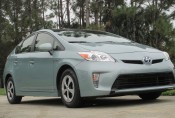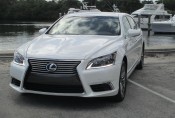2013 Ford C-MAX Energi
Standup: The benefit of adding a cord to a hybrid is pretty straightforward; you can drive much farther using battery power alone thus significantly increasing your MPGs. And the new Ford C-MAX Energi boasts some pretty impressive mileage numbers.
The term is MPGe, or miles per gallon equivalent and it’s how the EPA converts a gallon of gas to kilowatt hours so that consumers can standardize the numbers they see on the sticker. For what it’s worth, the C-MAX Energi receives a 100mpge combined rating, better than the Toyota Prius Plug-in Hybrid and the Chevy Volt. If you were to operate it using the 2.0-liter 4-cylinder gas engine alone, it gets a 43mpg rating. Though well intentioned, I’m afraid these mileage breakdowns and conversions only lend to the mass confusion about hybrids and their various technologies. Here’s the bottom line; much more so than gasoline powered cars, vehicles like the C-MAX Energi that bring electricity into the mix are subject to greater variances in fuel economy – and it all depends on you, how and where you drive and how diligent you are in recharging the battery. So as not to bury the lead, my average this week in the C-MAX Energi finished at 86mpg.
Ford sells both the C-MAX Hybrid and C-MAX Energi Plug-in Hybrid to give consumers the choice of using a cord. Yet another confusing aspect for consumers, pricing is tricky. Ford stickers the C-MAX Energi at about $4,500 more than the hybrid BUT the Energi comes in a single well-equipped trim, not 2 like the Hybrid, and it also qualifies for a $3,751 federal tax credit, something the hybrid isn’t afforded. Factor in that the EPA estimates that the C-MAX Energi buyer will save $1,000 more per year in fuel costs and all of a sudden the real price of this car is less than the C-MAX Hybrid.
But that’s not to say there aren’t some sacrifices to be made. The 7.6 kWh Lithium-ion battery used here delivers more than 5 times the energy of the battery used in the hybrid and thus eats up more cargo room…there’s 10 cubic feet less behind the first row. So the C-MAX’s versatility definitely takes a hit. And though you can plug into a regular household outlet to recharge in about 7 hours when fully depleted, a 240 volt quick charger like the ones found at grocery stores and hotels take only 2 ½ hours and would be an additional investment.
Otherwise the Energi drives with the same unexpected level of enjoyment I found in the regular C-MAX with strong and instantaneous torque and sharp driving manners and can motor on electricity alone up to an impressive 85mph. On average, I started off with about 12 miles of battery power on a full charge before regular hybrid operation took over. And there are myriad ways of keeping an eye on all things relating to energy usage and fuel economy, including a smartphone app that allows you to keep an eye on charge status and even schedule charging.
Ford also gives drivers a number of EV modes from which to choose, for instance one that permits you to save electricity for later usage. Hybrid operation is so smooth in its transitions that you often can’t tell what’s driving the front wheels.
MSRP of this loaded C-MAX Energi including a panoramic sunroof, premium audio with navi, tech package, a power liftgate with the neat foot-activated trick, rear view camera, keyless operation and an automated parking system is $38,215…again, before tax credits. Seeing as how no one gets the advertised 47mpg of the C-MAX Hybrid and the fact that Energi model might end up costing less, this car should be seriously considered.

 2021 BENTLEY BENTAYGA V8 TEST DRIVE
2021 BENTLEY BENTAYGA V8 TEST DRIVE 2013 Toyota Prius – Quick Takes
2013 Toyota Prius – Quick Takes 2013 Lexus LS 460 L – Quick Takes
2013 Lexus LS 460 L – Quick Takes